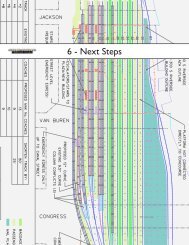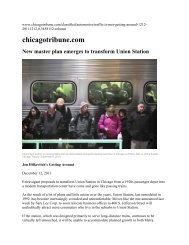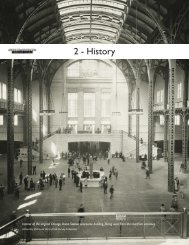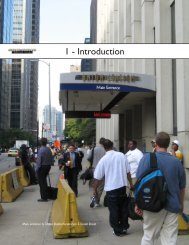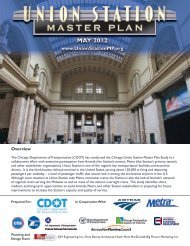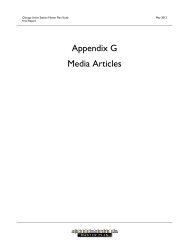6 â Next Steps and Credits.pdf - Chicago Union Station Master Plan
6 â Next Steps and Credits.pdf - Chicago Union Station Master Plan
6 â Next Steps and Credits.pdf - Chicago Union Station Master Plan
Create successful ePaper yourself
Turn your PDF publications into a flip-book with our unique Google optimized e-Paper software.
6 - <strong>Next</strong> <strong>Steps</strong>
May 2012<br />
<strong>Chicago</strong> <strong>Union</strong> <strong>Station</strong> <strong>Master</strong> <strong>Plan</strong> Study<br />
This master planning study has advanced <strong>and</strong> developed numerous ideas that are intended to address<br />
major functional <strong>and</strong> operational issues affecting <strong>Chicago</strong> <strong>Union</strong> <strong>Station</strong> in the short, medium, <strong>and</strong> long<br />
term. The next steps for these ideas vary, but all involve proceeding with further planning, design, <strong>and</strong>/or<br />
construction to achieve the benefits identified in the preceding chapters. The overarching objective is to<br />
move each of these projects from ideas into construction <strong>and</strong> operation.<br />
The Short Term ideas described in this report are already well advanced in planning <strong>and</strong> design, <strong>and</strong> in the<br />
case of CDOT’s off street bus terminal <strong>and</strong> improved bus lane projects grant funds have been obtained<br />
for their construction. Several near term Amtrak customer facility improvement projects have also had<br />
their design work largely completed, but construction is not yet funded. Obtaining funding to complete<br />
these initiatives, as well as addressing Amtrak’s outst<strong>and</strong>ing “state of good repair” needs throughout <strong>Union</strong><br />
<strong>Station</strong> should be a priority next step.<br />
“Medium Term” ideas in this study are<br />
focused on resolving serious operational<br />
shortcomings that have a direct impact<br />
on the ability of <strong>Union</strong> <strong>Station</strong> to serve a<br />
growing number of passengers.<br />
The Medium Term projects that have been identified are all focused on resolving serious operational<br />
shortcomings (including train operations, congestion in the concourse, <strong>and</strong> street level access needs)<br />
that have a direct impact on the ability of <strong>Union</strong> <strong>Station</strong> to serve a growing number of passengers. These<br />
projects will require further planning analysis <strong>and</strong> design work before they are ready to be funded for<br />
construction. The following next steps are proposed for these ideas:<br />
* Test each of the proposed ideas using simulation models to evaluate their ability to increase<br />
passenger <strong>and</strong>/or train capacity consistent with the projected increases in travel dem<strong>and</strong>. This will<br />
be the focus of the next stage of the CDOT-led <strong>Union</strong> <strong>Station</strong> <strong>Master</strong> <strong>Plan</strong> Study.<br />
* Once these ideas are refined further using the simulation models, the stakeholder agencies will<br />
need to identify which organization(s) will serve as the lead sponsor for each of the individual<br />
projects. These organizations in turn will:<br />
* Perform additional feasibility studies, as needed – especially to better underst<strong>and</strong> any structural<br />
implications of the proposed improvements on the buildings above<br />
* Lead the preliminary engineering <strong>and</strong> final design efforts for individual projects, including<br />
obtaining any required environmental clearances<br />
* Secure funding for both design <strong>and</strong> construction, <strong>and</strong> oversee construction<br />
* Continue public outreach for individual projects.<br />
The next stage of the <strong>Union</strong> <strong>Station</strong> <strong>Master</strong> <strong>Plan</strong> Study, involving simulation of train <strong>and</strong> station operations,<br />
will more precisely quantify the capacity increase that may be expected from each of the Medium Term<br />
ideas. Once the scale of these potential capacity improvements is known, the <strong>Union</strong> <strong>Station</strong> stakeholders<br />
will be able to compare the projected future growth in travel dem<strong>and</strong> through the station with the<br />
73
<strong>Chicago</strong> <strong>Union</strong> <strong>Station</strong> <strong>Master</strong> <strong>Plan</strong> Study<br />
May 2012<br />
cumulative potential capacity increase from these projects<br />
<strong>and</strong> effectively determine how many years worth of growth<br />
the Medium Term improvements will provide. In essence,<br />
the upcoming modeling analysis will define just how long<br />
the “medium term” is likely to be, <strong>and</strong> how soon the<br />
stakeholders will need to begin more serious consideration<br />
of the “long term/visionary” ideas for increasing capacity<br />
<strong>and</strong> improving the station’s functionality.<br />
The Medium Term ideas have thus far been conceived such<br />
that each of them would complement <strong>and</strong> not preclude<br />
or make more difficult the implementation of any of<br />
the more complex <strong>and</strong> expensive Long Term/Visionary<br />
ideas. However, the Long Term/Visionary ideas include<br />
Trains departing <strong>Union</strong> <strong>Station</strong><br />
two mutually exclusive alternatives for adding track <strong>and</strong><br />
platform capacity via new underground alignments, as well<br />
as two other mutually exclusive alternatives for creating new station building facilities in either the 200<br />
or 300 block of South Canal Street. Further analysis <strong>and</strong> public/stakeholder consultation will be needed<br />
to assess <strong>and</strong> determine the relative merits of each of these long term/visionary proposals <strong>and</strong> to decide<br />
which alternatives should advance towards implementation.<br />
“Medium Term” ideas can improve<br />
<strong>Union</strong> <strong>Station</strong> without precluding<br />
future implementation of “Long Term /<br />
Visionary” ideas.<br />
In addition to increasing capacity at <strong>Union</strong> <strong>Station</strong>, a primary function of the alternatives among the Long<br />
Term/Visionary proposals is placemaking. Either of the new/exp<strong>and</strong>ed station alternatives are intended to<br />
increase <strong>Union</strong> <strong>Station</strong>’s visibility <strong>and</strong> provide a stronger sense of arrival than the current basement-level<br />
station which is difficult to navigate. In either of these new station alternatives, space would be available<br />
to create passenger facilities <strong>and</strong> customer amenities with appropriately gr<strong>and</strong> views of the <strong>Chicago</strong> River<br />
<strong>and</strong> the surrounding downtown <strong>Chicago</strong> environment. Furthermore, the redevelopment of the station can<br />
serve as a catalyst for much needed adjacent development as well. In addition, the project will require the<br />
use of some innovative financing tools which are not well utilized in <strong>Chicago</strong>. The <strong>Union</strong> <strong>Station</strong> <strong>Master</strong><br />
<strong>Plan</strong> Study team has worked closely with a Civic Advisory Committee established by the Metropolitan<br />
<strong>Plan</strong>ning Council to advance the placemaking goal <strong>and</strong> an innovative financing strategy.<br />
The Civic Advisory Committee believes the station’s redesign should favor the creation of vibrant public<br />
spaces that have the potential to transform an imposing historic structure into one that invites interaction<br />
with its users <strong>and</strong> the surrounding city. In other words, the station should evolve into both an efficient<br />
intercity <strong>and</strong> regional railroad hub, with easy connections to other transit modes, <strong>and</strong> a truly great place<br />
that attracts transit users <strong>and</strong> non transit users alike. <strong>Union</strong> <strong>Station</strong> should be transformed into an iconic<br />
destination that takes advantage of its riverfront location with places for people to gather, as well as<br />
74
May 2012<br />
<strong>Chicago</strong> <strong>Union</strong> <strong>Station</strong> <strong>Master</strong> <strong>Plan</strong> Study<br />
internal spaces that draw people for dining <strong>and</strong> shopping as well as boarding trains. As major employers<br />
deliberately relocate to the area to be part of a dynamic urban fabric <strong>and</strong> be proximate to transportation,<br />
the station can act as an economic engine that has a positive impact not only on nearby blocks in the West<br />
Loop area, but on the City <strong>and</strong> the <strong>Chicago</strong> area as a whole.<br />
New or exp<strong>and</strong>ed station facilities would be a large scale project, likely costing in the hundreds of millions<br />
of dollars that will increase the value of surrounding property. It therefore behooves the <strong>Union</strong> <strong>Station</strong><br />
stakeholders <strong>and</strong> the civic community to seriously explore innovative approaches to project financing<br />
that will most effectively leverage the value that these improvements will add to nearby real estate. The<br />
analysis of Real Estate Issues <strong>and</strong> Opportunities (presented in Appendix E) <strong>and</strong> the report on <strong>Chicago</strong><br />
<strong>Union</strong> <strong>Station</strong> Concepts in Context (presented in Appendix H) conducted as part of this Study, provide<br />
information regarding other major rail station projects around the U.S., <strong>and</strong> the world, including some<br />
discussion as to the methods used to finance these projects. Prospective new <strong>Chicago</strong> <strong>Union</strong> <strong>Station</strong><br />
facilities could, for instance, be designed in a manner to allow an office tower to be constructed on air<br />
rights above the station <strong>and</strong>/or on adjacent Amtrak- <strong>and</strong> City-owned parcels, creating an iconic mixeduse<br />
development that is sensitive both to the needs of rail passengers as well as commercial real estate<br />
development opportunities.<br />
The Metropolitan <strong>Plan</strong>ning Council, <strong>and</strong> its <strong>Union</strong> <strong>Station</strong> Civic Advisory Committee, is proactively assessing<br />
such <strong>Union</strong> <strong>Station</strong>-related development opportunities, with particular focus on methods of financing.<br />
In addition to being a transportation hub, Washington D.C.’s <strong>Union</strong> <strong>Station</strong> features multi-level<br />
retail <strong>and</strong> dining opportunities (Marcin Wichary)<br />
75
<strong>Chicago</strong> <strong>Union</strong> <strong>Station</strong> <strong>Master</strong> <strong>Plan</strong> Study<br />
May 2012<br />
Tools such as value capture financing have been used successfully throughout the country to finance<br />
new or existing transportation infrastructure. It is good policy precisely because it connects the benefit<br />
(<strong>and</strong> benefactors) of the investment with its cost. Financing options under exploration include various<br />
forms of Public Private Partnerships (PPP), Tax Increment Financing (TIF), Special Assessment (SSA <strong>and</strong><br />
SA), air rights, <strong>and</strong> federal infrastructure loan programs such as those available through the Transportation<br />
Infrastructure Finance <strong>and</strong> Innovation Act (TIFIA) program. <strong>Union</strong> <strong>Station</strong>’s redevelopment could be part<br />
of a larger transportation district that would leverage opportunities on multiple transit-related sites to<br />
provide financial support for transportation improvements <strong>and</strong> other enhancements. At this stage of study,<br />
it appears that developing the air rights above the transportation improvements on the 300 south block<br />
<strong>and</strong> the Amtrak parking garage block should be a high priority. These two blocks represent attractive<br />
sites for future high-density office development. If structured appropriately, a portion of the proceeds<br />
from future private-sector development on these sites could help fund transportation improvements <strong>and</strong><br />
advance the City’s economic development objectives as described in the Central Area ACTION <strong>Plan</strong>.<br />
“Long Term / Visionary” ideas will create<br />
an iconic railroad station that integrates<br />
placemaking principles <strong>and</strong> drives<br />
economic development.<br />
76
May 2012<br />
<strong>Chicago</strong> <strong>Union</strong> <strong>Station</strong> <strong>Master</strong> <strong>Plan</strong> Study<br />
<strong>Credits</strong><br />
City of <strong>Chicago</strong>, The Honorable Rahm Emanuel, Mayor<br />
<strong>Chicago</strong> Department of Transportation<br />
Gabe Klein, Commissioner<br />
Luann Hamilton, Deputy Commissioner<br />
Jeffrey Sriver, Project Manager<br />
Richard Hazlett, Past Project Manager (retired)<br />
Technical Advisory Committee<br />
Jeffrey Sriver, <strong>Chicago</strong> Dept of Transportation, Chair<br />
Richard Hazlett, <strong>Chicago</strong> Dept of Transportation,<br />
Past Chair<br />
Akheel Ahmed, <strong>Chicago</strong> Transit Authority<br />
Sid Birckett, Amtrak<br />
Claire Bozic, <strong>Chicago</strong> Metropolitan Agency for <strong>Plan</strong>ning<br />
Lynnette Ciavarella, Metra<br />
Richard Cogswell, Federal Railroad Administration<br />
Jon Czerwinski, <strong>Chicago</strong> Transit Authority<br />
Wynne Davis, Federal Railroad Administration<br />
Peter Fahrenwald, Regional Transportation Authority<br />
Mike Franke, Amtrak<br />
Allen Fugate, Coach USA<br />
Josel Gonzales, Metra<br />
Miriam Gutierrez, Illinois Department of Transportation<br />
Benet Haller, <strong>Chicago</strong> Dept of Housing <strong>and</strong> Economic<br />
Development<br />
George Hardwidge, Metra<br />
Joe Iacobucci, <strong>Chicago</strong> Transit Authority<br />
Derrick James, Amtrak<br />
Jan Jantzen, Free Enterprise System<br />
Harold Kirman, Amtrak<br />
Daniel Klaiber, <strong>Chicago</strong> Dept of Housing <strong>and</strong> Economic<br />
Development<br />
Dave Klouda, Amtrak<br />
David Kralik, Metra<br />
Walter L<strong>and</strong>er, Amtrak<br />
Ray Lang, Amtrak<br />
Rosie Leal, Amtrak/Jones Lang LaSalle<br />
Joe Lorenzini, Metra<br />
Marc Magliari, Amtrak<br />
Wendy Messenger, Federal Railroad Administration<br />
Mark Minor, Regional Transportation Authority<br />
Yadollah Montazery, <strong>Chicago</strong> Dept of Transportation<br />
Charlie Monte Verde, Amtrak<br />
Marisa Novara, Metropolitan <strong>Plan</strong>ning Council<br />
Don Orseno, Metra<br />
Todd Popish, Illinois Department of Transportation<br />
Andy Roth, Metra<br />
Malihe Samadi, <strong>Chicago</strong> Dept of Transportation<br />
Moe Savoy, Amtrak<br />
Jim Schwartz, Coach USA<br />
Joe Shacter, Illinois Department of Transportation<br />
Peter Skosey, Metropolitan <strong>Plan</strong>ning Council<br />
Joanna Trotter, Metropolitan <strong>Plan</strong>ning Council<br />
Frank Tverdek, Amtrak/Jones Lang LaSalle<br />
Robert Vance, <strong>Chicago</strong> Transit Authority<br />
Stephen VanGalder, Coach USA<br />
Doug Varn, Amtrak<br />
Pete Zwolfer, Metra<br />
77
<strong>Chicago</strong> <strong>Union</strong> <strong>Station</strong> <strong>Master</strong> <strong>Plan</strong> Study<br />
May 2012<br />
Civic Advisory Committee<br />
Cass<strong>and</strong>ra Francis, Kariatid LLC, Co-Chair<br />
Benet Haller, <strong>Chicago</strong> Department of Housing <strong>and</strong><br />
Economic Development, Co-Chair<br />
Peter Skosey, Metropolitan <strong>Plan</strong>ning Council, Staff<br />
Marisa Novara, Metropolitan <strong>Plan</strong>ning Council, Staff<br />
Alderman Bob Fioretti, 2nd Ward<br />
Alderman Walter Burnett, 27th Ward<br />
Alderman Brendan Reilly, 42nd Ward<br />
Lee Bey, <strong>Chicago</strong> Central Area Committee<br />
Mark Bookman, Ernst & Young, LLC<br />
Kevin Brubaker, Environmental Law & Policy Center<br />
Lynnette Ciavarella, Metra<br />
Michael Cornicelli, Building Owners & Management<br />
Association of <strong>Chicago</strong><br />
Bob Dean, <strong>Chicago</strong> Metropolitan Agency for <strong>Plan</strong>ning<br />
Jon DeVries, Roosevelt University<br />
Madeline Doering, Office of Alderman Brendan Reilly<br />
Ann Drake, DSC Logistics, Inc.<br />
Jim Farrell, Infrastructure First<br />
Bernard Ford, McDonough Associates, Inc.<br />
Linda Goodman, Goodman Williams Group<br />
Rick Harnish, Midwest High Speed Rail Association<br />
Jennifer Henry, Natural Resources Defense Council<br />
Joe Iacobucci, <strong>Chicago</strong> Transit Authority<br />
Dan Klaiber, <strong>Chicago</strong> Department of Housing <strong>and</strong><br />
Economic Development<br />
Ray Lang, Amtrak<br />
Michael Mini, <strong>Chicago</strong>l<strong>and</strong> Chamber of Commerce<br />
Paul Nowicki, BNSF Railway Company<br />
Stephen R. Patterson, Drinker Biddle & Reath, LLP<br />
Mike Payette, <strong>Union</strong> Pacific Corporation<br />
David Phillips, TranSystems Corporation<br />
Michael Prussian, General Parking Corporation<br />
Jorge Ramirez, HACIA<br />
Gerald Roper, <strong>Chicago</strong>l<strong>and</strong> Chamber of Commerce<br />
Joe Schacter, Illinois Department of Transportation<br />
Jeffrey Sriver, <strong>Chicago</strong> Department of Transportation<br />
Marty Stern, U.S. Equities Realty, LLC<br />
Tim Stevens, Office of Alderman Bob Fioretti<br />
Ty Tabing, <strong>Chicago</strong> Loop Alliance<br />
Michael Tobin, U.S. Equities Realty, LLC<br />
Brian Urbaszewski, Respiratory Health Association of<br />
Metropolitan <strong>Chicago</strong><br />
George Weber, Illinois Department of Transportation<br />
Tom Wolf, Illinois Chamber of Commerce<br />
Kathleen Woodruff, T4 America<br />
Ferhat Zerin, Gingko <strong>Plan</strong>ning<br />
<strong>Plan</strong>ning <strong>and</strong> Design Team<br />
TranSystems Corporation<br />
EJM Engineering, Inc.<br />
Ross Barney Architects<br />
Hatch Mott MacDonald<br />
Big Picture Marketing, Inc.<br />
Goodman Williams Group<br />
78
www.<strong>Union</strong><strong>Station</strong>MP.org



